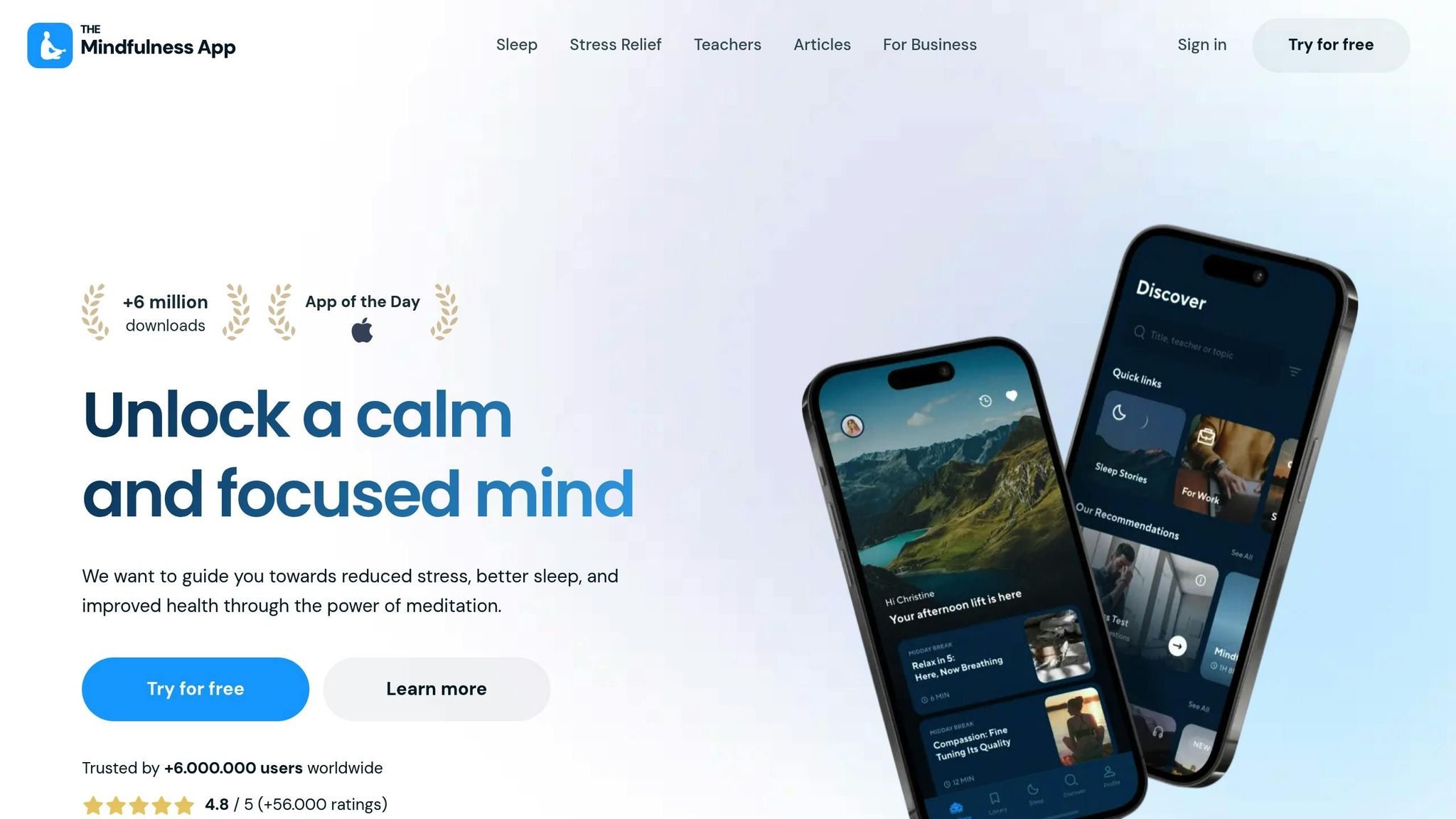Cravings can feel overpowering, but mindful eating meditation offers tools to help you pause, reflect, and make intentional choices. Instead of reacting impulsively, this practice helps you understand the root causes of cravings - whether emotional, physical, or environmental - and respond in a way that aligns with your needs.
Here’s what you’ll learn:
- Cravings Explained: Emotional triggers, brain reward systems, and physical factors like blood sugar or dehydration often drive cravings.
- Mindful Eating Basics: It’s about distinguishing true hunger from emotional urges, being present during meals, and reducing distractions.
- Techniques to Manage Cravings: Practices like mindful breathing, body scans, and the STOP method help you pause and respond thoughtfully.
- Daily Integration: Start small, like focusing on one mindful meal a day, and create a calm eating space free from distractions.
- Support Tools: Apps like The Mindfulness App provide guided meditations and programs to help you stay on track.
Mindful eating isn’t about restriction - it’s about creating awareness and building a healthier relationship with food. Start by trying one practice, like pausing to breathe before eating, and notice how it changes your experience.
What Are Cravings and Mindful Eating
What Are Cravings?
Cravings are those strong desires for specific foods that often feel impossible to ignore. Maybe it’s a late-night urge for pizza or an overwhelming need for ice cream after a tough day - even when you’re not physically hungry.
These cravings tap into the brain’s reward system, releasing dopamine, the chemical that makes you feel good. When you eat something you love, your brain remembers the pleasure and creates a pattern, encouraging you to seek out those foods again. That’s why your comfort foods tend to stay consistent - they’re tied to moments of relief or happiness that your brain doesn’t want to forget.
Emotions are a big driver of cravings. Stress, boredom, sadness, or even joy can all spark a desire for certain foods. For instance, stress might have you reaching for crunchy snacks, while sadness could push you toward sweet treats that once brought comfort.
Cravings can also stem from physical factors like fluctuating blood sugar, hormonal changes, or even dehydration. For example, hormonal shifts during a menstrual cycle can lead to cravings for chocolate or salty foods. Dehydration, surprisingly, can sometimes trick your body into thinking it needs sweet foods.
Then there are the environmental triggers - the smell of freshly baked cookies, a tempting food ad, or walking past your favorite restaurant. These sensory cues light up the brain’s pathways, making you crave specific foods even if you weren’t thinking about them before.
Recognizing these triggers is the first step toward managing them - and that’s where mindful eating comes in.
What Is Mindful Eating?
Mindful eating helps you distinguish between emotional cravings and genuine physical hunger. It’s about being fully present during meals and understanding the difference between a gradual, physical need for food and a sudden, emotional urge. Physical hunger grows slowly, can be satisfied with a variety of foods, and fades once you’re full. Emotional hunger, on the other hand, comes out of nowhere, demands specific comfort foods, and often lingers even after you’ve eaten.
This practice encourages you to tune in to your body’s natural hunger and fullness signals. Before eating, you might pause and ask yourself: “Am I truly hungry, or is something else driving me to eat?” During meals, you focus on the flavors, textures, and smells of your food, while also paying attention to when your body feels satisfied.
Mindful eating also involves noticing your emotions and thoughts around food without judgment. When a craving strikes, instead of immediately giving in, you take a moment to reflect. Are you feeling stressed? Bored? Celebratory? This pause creates a gap between the craving and your response, giving you the chance to make a conscious choice.
Another key aspect is removing distractions so you can fully engage with your meal. That means sitting down to eat, putting away your phone or laptop, and savoring each bite. This not only enhances the experience but also helps you recognize when you’re full.
Mindful eating isn’t about strict diets or food restrictions. It’s about building a healthier relationship with food - one rooted in awareness, curiosity, and kindness toward yourself. By eating mindfully, you’re more likely to enjoy your meals, feel satisfied with smaller portions, and make choices that genuinely nourish your body instead of being driven by habit or emotion.
How Mindfulness Meditation Helps with Cravings
The Science of Mindfulness and Cravings
Mindfulness meditation has a powerful way of reshaping how your brain responds to cravings. It strengthens the prefrontal cortex - the part of your brain responsible for decision-making - and helps calm the amygdala, which governs emotional responses. This rewiring creates a larger gap between the moment you feel a craving and the action you take. In other words, it gives you the mental space to pause and consider your choices instead of acting on impulse.
Another key benefit is how mindfulness helps regulate cortisol, the stress hormone that often fuels cravings, especially for high-calorie comfort foods. By stabilizing cortisol levels, mindfulness can reduce the intensity of cravings that arise during stressful moments.
Mindfulness also enhances cognitive flexibility, which is your ability to observe thoughts and feelings without being controlled by them. For example, when a craving strikes, instead of immediately thinking, "I need to eat this chocolate bar", mindfulness allows you to step back and notice, "I'm having the thought that I want chocolate. What’s actually going on here?" This shift in perspective can make a big difference.
Another fascinating effect of mindfulness is its ability to improve interoceptive awareness - your sensitivity to internal body signals. This helps you differentiate between true physical hunger, emotional needs, and ingrained habits. You might discover that what you thought was hunger is actually thirst, tiredness, or simply a desire for comfort.
Benefits of Mindful Eating Meditation
Mindful eating meditation builds on these brain changes to deliver practical, real-world benefits. By addressing emotional and habitual triggers, it helps you break free from patterns like eating out of boredom or stress.
One major benefit is improved stress management. Instead of turning to food as a default stress reliever, you learn alternative ways to cope. For instance, you might notice tightness in your shoulders and decide to take a few deep breaths or go for a short walk instead of reaching for a snack.
This practice also sharpens your awareness of eating triggers. Over time, you start noticing patterns - like always craving sweets after a tough conversation or reaching for salty snacks when you're procrastinating. Recognizing these triggers gives you the power to prepare for them or address the underlying emotions directly.
Portion control becomes easier too. Mindful eating allows you to tune into your body’s signals of fullness, helping you stop eating when you’re satisfied rather than overindulging.
Another perk? You’ll enjoy your food more. When you eat mindfully, you savor every bite, which means smaller portions can feel just as satisfying. The overall quality of your eating experience improves, even if you’re eating less.
Mindfulness can also positively impact your sleep quality. Emotional eating or late-night cravings often disrupt sleep patterns, but as you become more aware of your habits and reduce stress-related eating, your body’s natural rhythms tend to stabilize.
Finally, mindful eating meditation nurtures self-compassion. Instead of feeling guilt or shame over occasional indulgences, you learn to treat yourself with kindness. This creates a healthier relationship with food, allowing new, positive patterns to emerge naturally.
Guided Meditation for Food Cravings
Step-by-Step Mindful Eating Meditation Practices
With an understanding of how mindfulness can reshape your brain's response to cravings, it’s time to put that knowledge into action. These practices are designed to help you bridge the gap between awareness and intentional response, giving you tools to manage cravings with clarity and calm.
Mindful Breathing to Pause Cravings
Cravings often trigger an automatic response, leading to impulsive choices. Mindful breathing introduces a pause, creating space to respond thoughtfully instead of reacting on instinct. This simple practice not only calms your nervous system but also reduces the stress or anxiety that often accompanies intense cravings.
When you feel a craving arise, shift your attention to your breath. Take slow, deliberate breaths, paying attention to the sensation of air moving in and out of your nostrils or the gentle rise and fall of your chest. You can also ground yourself by noticing the feeling of your feet on the floor.
As you breathe, observe the craving without judgment. Instead of resisting it or feeling guilty, view it as a passing experience - like clouds drifting across the sky. Give yourself at least a minute to practice this technique. You may notice the craving losing its intensity, giving you the clarity to make a deliberate choice about how to respond.
Once you've calmed your mind, you can deepen your awareness with a body scan meditation.
Body Scan Meditation for Craving Awareness
Your body often signals cravings through physical sensations tied to stress or emotions. A body scan meditation helps you tune into these signals, offering insights into what your body truly needs.
Find a comfortable position - sitting or lying down - and close your eyes. Begin by taking a few deep breaths to settle yourself. Then, slowly shift your focus from the top of your head down to your toes, paying attention to any tension, tightness, or unusual sensations along the way.
When you notice areas of discomfort, breathe into them. Don’t try to change the sensations; simply observe them with curiosity. For example, you might realize that what you thought was hunger is actually stress manifesting as chest tightness, or that a craving for crunchy snacks is linked to jaw tension after a tough day. This practice helps you understand the root of your cravings, allowing you to address your needs more thoughtfully instead of masking them with food.
The goal here isn’t to fix or eliminate sensations but to acknowledge them with care. This creates a moment of mindfulness that can shift how you respond to cravings.
Using the STOP Technique
The STOP technique is a practical tool for managing cravings in the moment. It’s a four-step process - Stop, Take a breath, Observe, and Proceed - that helps you turn automatic reactions into intentional actions.
- Stop: Pause immediately when a craving hits. Even a brief moment of stillness can interrupt the cycle of impulsive behavior.
- Take a breath: Take a few deep, mindful breaths. Focus on each inhale and exhale to anchor yourself in the present.
- Observe: Check in with yourself. What are you feeling emotionally? Are you experiencing physical hunger, or is the craving tied to stress, boredom, or another emotion? Notice where the craving shows up in your body and how it feels.
- Proceed: Decide your next step based on what you’ve observed. If you’re truly hungry, eat mindfully - choosing food intentionally and savoring every bite. If the craving is emotional, consider redirecting your attention to something else, like a favorite activity or more mindful breathing.
This process empowers you to make choices that align with both your physical and emotional needs, gradually building confidence in your ability to manage cravings.
Once you’ve paused and reflected, take it a step further by checking in with yourself before eating.
Mindful Check-In Before Eating
Before you eat, take a moment to pause and reflect. This mindful check-in helps ensure your decision to eat is intentional, not automatic.
Start by assessing your physical hunger. Rate it on a scale from 1 to 10, where 1 means you’re completely full and 10 indicates intense hunger. True hunger often feels like gentle stomach sensations or a gradual need for energy, rather than a sudden, overpowering urge.
Next, consider your emotional state. Are you feeling stressed, anxious, bored, or celebrating something? Examine whether your desire to eat is triggered by external cues - like the smell of food - or comes from within.
Finally, think about your environment and timing. Are you eating because it’s mealtime, because food is easily accessible, or because others around you are eating? This brief pause allows you to determine whether to eat right away, wait and reassess, or address an emotional need in another way, like drinking water or taking a short walk.
sbb-itb-bea8dce
Making Mindful Eating a Daily Habit
Turning mindful eating into a regular part of your day doesn’t have to feel overwhelming. By making small, consistent changes, you can integrate these practices into your routine until they feel natural - something you do without even thinking about it.
Start small. Focus on practicing mindful eating with just one meal a day, then gradually expand to include more. These small steps build on the mindful techniques you’ve already learned and make it easier to stick with them.
Creating a Mindful Eating Environment
Your surroundings have a big impact on how you eat. A calm, focused environment can help you stay present during meals, while distractions can pull you into mindless eating.
- Set up a designated eating space. Choose a specific spot where you can eat without interruptions. Over time, your brain will associate this space with mindful eating, making it easier to stay focused.
- Eliminate distractions. Keep your phone in another room, turn off the TV, and close your laptop. Without these interruptions, you can better tune in to your hunger and fullness signals.
- Slow down your pace. Using smaller plates or utensils can naturally encourage you to eat more slowly and pay closer attention to each bite.
- Add visual reminders. Place small prompts, like a note or an object, near your eating space to remind you to engage your senses while eating.
- Prepare meals with care. As you cook or assemble your food, notice the colors, textures, and smells of the ingredients. This simple act can help you transition from the rush of daily life to a more mindful state.
By shaping your environment to support mindful eating, you’ll find it easier to maintain focus and resist the pull of distractions.
Overcoming Challenges in Mindful Eating
Even with the right environment, challenges - both internal and external - can make mindful eating tricky. Being aware of these obstacles and planning ahead can help you stay on course.
Emotional eating is a common hurdle. Stress, sadness, or anxiety can often lead to cravings for comfort foods. Instead of ignoring these feelings, acknowledge them with kindness. Create a "pause toolkit" of go-to alternatives, like calling a friend, taking a walk, stretching, or practicing deep breathing. These activities can help you manage emotions without turning to food.
Time pressures and social settings can also disrupt mindful eating. When you’re busy or overwhelmed, try pre-planning snacks or meals that are easy to grab and enjoy, even if you only have a few minutes. In social situations like family dinners or work events, distractions and large portions can make it harder to stay mindful. Set a simple intention before the meal - whether it’s savoring one dish or checking in with your hunger levels halfway through.
Perfectionism can be another stumbling block. You don’t need to eat mindfully all the time to benefit. If you catch yourself eating on autopilot, don’t beat yourself up. Instead, gently refocus and continue practicing. Every meal is a chance to reconnect with your mindful approach.
Cravings are bound to happen, but they can also be opportunities for growth. Techniques like the STOP method or mindful check-ins become more effective the more you use them, even when cravings feel strong.
To make this habit stick, ease into it. Start with one mindful meal a day - breakfast is often a good choice since it’s usually eaten alone and can set the tone for the day. As you get more comfortable, extend this practice to other meals and snacks.
Finally, track your progress in a way that feels rewarding. Whether you mark your mindful meals on a calendar or jot down quick reflections about your eating experiences, celebrating these small wins can help reinforce your new habits.
Tools and Resources for Mindful Eating Support
Incorporating mindful eating into your daily life can be challenging, but the right tools can make a big difference. Digital resources, like apps, can offer support and structure when you're navigating cravings or trying to stay on track with your goals.
The trick is to find options that fit seamlessly into your routine. Whether you're at work battling mid-afternoon hunger or dealing with late-night emotional eating, having accessible tools at your fingertips can be a game-changer. One excellent option to consider is The Mindfulness App, which is designed to support mindful eating practices.
How The Mindfulness App Can Help

The Mindfulness App is packed with tools to help you stay present and manage cravings. It features over 500 guided meditations in 12 languages, covering everything from body scans and breathing exercises to stress management techniques. These meditations are particularly helpful for recognizing hunger cues and creating a pause before giving in to cravings.
What’s great is that you can download sessions to use offline, so you're never without support - even if you're on the go. The app also offers a 14-day free trial, giving you full access to its premium library. Whether you need a quick 5-minute meditation for immediate relief or a longer 20-minute session for deeper reflection, there’s something for everyone.
Beyond the meditation library, The Mindfulness App also provides specialized programs to help you tackle cravings more effectively.
Personalized Programs for Craving Management
Understanding that each person's relationship with food is unique, The Mindfulness App offers personalized programs tailored to your specific challenges. These programs focus on areas like stress eating, emotional triggers, and late-night cravings, helping you address the root causes of these behaviors.
The programs include guided meditations, sleep stories, and courses designed to help balance hunger cues and reduce cravings. They also take into account lifestyle factors that may influence your eating habits, offering a holistic approach to mindful eating.
With these tools available right on your phone, you can check in with yourself whenever you need to - whether it’s a quick pause before a meal, a moment to reflect during a craving, or some time to process after a difficult eating experience. Having this kind of support at your fingertips can make mindful eating feel more achievable, no matter the situation.
Conclusion
Mindful eating meditation offers a fresh perspective on how we relate to food and manage cravings. By blending mindfulness practices with eating habits, it becomes easier to identify genuine hunger, recognize emotional triggers, and create a moment of pause between feeling an urge and acting on it.
Practical techniques like mindful breathing, body scans, the STOP method, and pre-meal check-ins equip you to handle cravings thoughtfully. These methods encourage you to pause, observe, and respond intentionally, rather than giving in to impulsive reactions.
The journey to building mindful eating habits takes time and patience. Start small - try adding just one or two techniques to your routine. Maybe take a few deep breaths before eating or do a brief body scan when a craving strikes. It's not about being perfect; it's about being consistent.
Studies suggest that mindfulness meditation can actually change how your brain processes cravings, making them feel less overwhelming and easier to handle over time. This approach isn’t about strict rules or sheer willpower - it’s about cultivating a greater awareness of your body’s needs and emotional patterns connected to food.
With resources like The Mindfulness App, you can access guided meditations and tailored programs whenever you need support. The key is to explore different techniques and discover what fits naturally into your life.
Why not start now? Choose one mindful eating practice and try it at your next meal. Change is possible, and mindful eating meditation offers a practical, sustainable way to reshape your relationship with food. By embracing these practices, you can take charge of your eating habits and foster a healthier, more intentional connection with food.
FAQs
How can mindful eating meditation help manage food cravings?
Mindful eating meditation is an effective way to navigate cravings by tuning into your body's natural cues, like distinguishing genuine hunger from emotional urges. By cultivating mindfulness, you create a moment to pause and reflect before responding to cravings, allowing for more thoughtful and balanced decisions rather than acting on impulse.
This practice invites you to immerse yourself in the experience of eating - paying close attention to the flavors, textures, and sensations of each bite. Over time, this heightened awareness can soften the grip of cravings and support a more harmonious relationship with food.
How can I start practicing mindful eating even with a busy schedule?
To truly enjoy your meals and connect with the experience, start by slowing down. Turn off distractions like your phone or TV, and give your full attention to your food. Notice the flavors, textures, and aromas with each bite, and take the time to chew thoroughly. Practice intentional eating by serving smaller portions and taking breaks to check in with your hunger levels. If this feels overwhelming, begin with just one mindful meal a day and gradually expand the habit. Fun tricks, like eating with your non-dominant hand or using chopsticks, can also help keep you focused and present during meals.
Can mindful eating meditation help reduce emotional eating?
Mindful eating meditation is a helpful approach to tackling emotional eating. It works by sharpening your awareness of your body’s natural hunger and fullness cues, giving you the chance to pause and reflect before diving into a meal. This practice encourages slowing down, truly savoring each bite, and identifying the emotional triggers that might be driving your cravings.
Additionally, mindful eating can ease stress-related cravings by fostering a sense of calm and balance. Over time, it can pave the way for a healthier relationship with food, making it easier to thoughtfully address emotions without resorting to impulsive eating.






